Pasta with frozen mixed vegetables is an easy & affordable dinner. This recipe uses a one-pot cooking method for both the pasta and frozen vegetables that makes this simple dish extra-flavorful.
Pasta with frozen mixed vegetables is a recipe that's perfect for the busiest nights of the week, when you're short on groceries and short on time.
This meal is ready in just 15 minutes! It's a filling, flavorful and family friendly pasta dish loaded with veggies.
Looking for more one-pot pasta recipes? Try miso mushroom spaghetti or one-pot spaghetti with tomatoes and kale.
Looking for more frozen vegetable recipes? Try crispy roasted frozen cauliflower with garlicky breadcrumbs and Instant Pot steamed broccoli (fresh or frozen) or frozen roasted green beans.
Why This Recipe Works
- Only 6 ingredients (plus water).
- No prep-work.
- Ready in 15 minutes.
- The one-pot cooking method adds extra flavor.
- Only one dish to clean!
- It's easy to always keep frozen veggies and pasta on hand, so you can make this meal without running to the grocery store.
Ingredients & Substitutions

Pasta: Short pasta shapes that cook in 8 to 12 minutes work best with this recipe. Try penne, cavatappi, small shells, fusilli or macaroni.
Mixed frozen vegetables: This recipe is written with mixed frozen veggies in mind, the type you can find in the freezer section at any grocery store. I use a blend of carrots, corn, peas, green beans and lima beans.
Broth + Water: Using vegetable or chicken broth gives this pasta more flavor. Just make sure to use broth that you really like, because the flavor of the broth will affect how the noodles taste. A small amount of water (¼ cup) is also added so that there is enough liquid to cook the pasta.
Instead of broth you can also just use salted water, although the pasta won't have quite as much flavor.
Garlic: Fresh garlic, finely chopped, is best. I guess garlic is optional, but it adds great flavor to this simple pasta!
Cheese: Completely optional, but as you know grated parmesan always adds more flavor to pasta!

The best frozen vegetables for pasta
Mixed frozen vegetables: Frozen mixed vegetables work really well and are the first choice. I use a blend of carrots, corn, lima beans, peas and green beans.
Peas and green beans: Frozen peas and green beans work great with this recipe.
Spinach and Kale: Frozen kale and spinach easily blend into this pasta. Keep in mind that most of the noodles will be coated in bits of spinach and kids won't be able to pick around it (I'll let you decide if this is a good or bad thing!) If you'd like a recipe that uses frozen spinach or kale, try one-pot spaghetti with tomatoes and kale.
Broccoli or Cauliflower: Florets of frozen broccoli or cauliflower are okay, but not my first choice. Frozen broccoli and cauliflower tend to be in larger chunks and have a softer texture that isn't as appetizing.

Step-by-Step Recipe Instructions
A one-pot pasta method is the best way to cook pasta with frozen vegetables because it adds the most flavor. The pasta absorbs all of the water that it cooks in, creating a flavorful, starchy "sauce" that clings to the noodles.
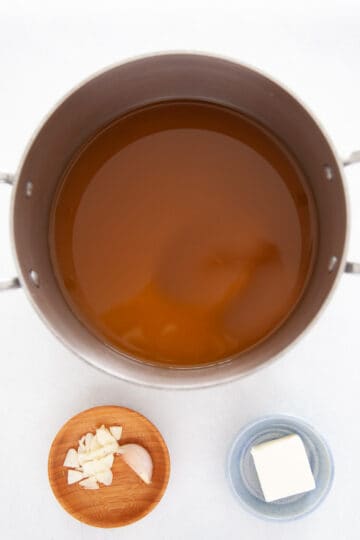
Step 1: Bring broth, water, garlic and butter to a boil.
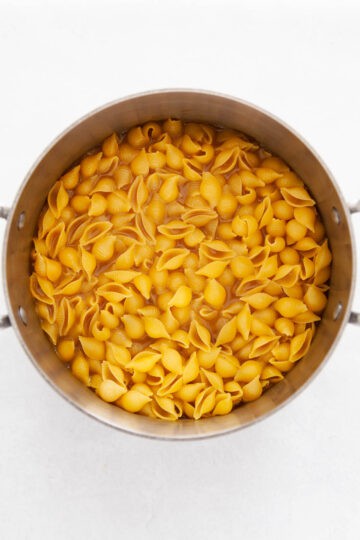
Step 2: Add pasta. Bring back to a simmer and cook pasta for 5 minutes. Mix frequently.
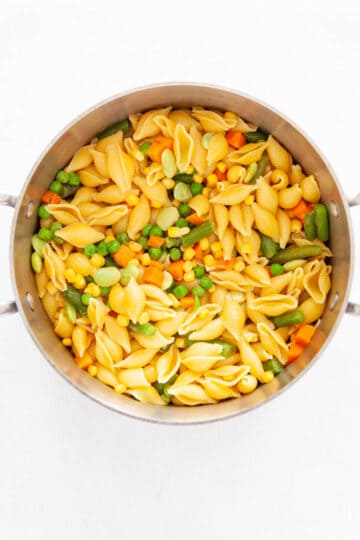
Step 3: Add the frozen mixed vegetables. Mix well. Continue to simmer for another 3 to 5 minutes until the pasta is tender and vegetables are warm.

Step 4: Turn off the heat and stir in the parmesan. Put a lid on the pot and let it sit for a minute or two.
For ingredient measurements, see the recipe card below.

Recipe FAQs
Short noodles that cook in 8 to 12 minutes work best for this recipe because they easily fit into a pot.
If you'd like to use longer noodles, you'll need to use a wide, straight-sided skillet. You'll also need to turn the long noodles frequently with tongs so that the pasta doesn't stick together. For specific instructions, check out this recipe for One Pot Spaghetti with Tomatoes and Kale.
The words "pasta" and "noodles" are often used interchangeably. If you want to get technical, there are slight differences. Mostly, it comes down to the type of flour that is used.
Traditionally, pasta is made from durum wheat that is ground into semolina flour. Semolina flour has a yellow color that gives pasta a yellowish hue. Durum wheat is high in gluten, which helps pasta hold its shape and have an al dente texture. Some types of pasta have egg in the dough, others just have flour and water.
Noodles often have a softer and more slippery texture than pasta. They are often long in shape, but noodles can also be short (like egg noodles). Noodles differ from pasta in that they can be made from different types of flour: semolina flour, all purpose flour, rice flour, bean flour and other flours. The color ranges from yellow to tan or a pale white. The texture can be al dente, or softer. A good example is rice flour (or pad thai) noodles.
Sure! When the pasta is completely cooked, drizzle in whole cream or half & half. Add a little bit at a time until the pasta is creamy enough. You can also stir in creme fraiche or full-fat Greek yogurt for a tangier flavor. Make sure to also add more salt if needed.
Cheese is optional, but does add more flavor.
Yes. Whole wheat pasta works well with the same amount of liquid and same cooking time.
Yes. To cook a smaller amount, use 8 ounce of dried pasta and 2 ¼ cups of liquid.
Reheating and Storage
To reheat the pasta, the easiest method is using a microwave. To reheat on the stove, add a few tablespoon of water to the pasta and reheat gently over medium heat, stirring often.
This pasta will stay fresh for up to 5 days in the refrigerator.
More Easy Pasta Recipes
Does this recipe make you hungry?
SUBSCRIBE
to the Kitchen Skip newsletter
for helpful tips, easy recipes
& good conversation
📖 Recipe
Pasta with Frozen Vegetables
Pasta with frozen vegetables is a fast, easy and affordable dinner. The one-pot cooking method is a simple trick that makes the pasta extra-flavorful.
This recipe was originally published on 10/21 and was updated on 9-26-2023.
- Cook Time: 15
- Total Time: 15 minutes
- Yield: 6 servings 1x
- Category: 30 Minutes Meals
- Method: simmer
- Cuisine: American
- Diet: Vegetarian
Ingredients
- 4 cups vegetable or chicken broth
- ¼ cup water
- 2 tablespoons salted butter
- 2 garlic cloves, thinly sliced or finely chopped
- 16 ounces short pasta (penne, small shells)
- 16 ounces mixed frozen vegetables
- ½ to 1 cup grated parmesan
Instructions
- In a sauce pot, bring the broth, water, butter and garlic to a boil.
- When the liquid is boiling, add the pasta. The pasta will just barely be covered by the broth.
- Set a timer for 5 minutes. Reduce the heat to medium and keep the broth at a rapid simmer. Stir the pasta frequently (keep the pot uncovered).
- After 5 minutes, add the frozen mixed vegetables. Mix well.
- Continue to simmer and frequently mix the pasta for another 3 to 5 more minutes until the pasta is tender. Most of the liquid will be absorbed at this point and will be completely absorbed when the pasta is ready.
- Turn off the heat and stir in the parmesan. Put a lid on the pot and let it sit for a minute or two.
- I usually add a generous pinch of salt after tasting the pasta. How much salt you’ll add depends on how salty the broth you bought is.
Notes
The total cooking time varies slightly depending on the size of the pot and the type of pasta you are using. Signs that the pasta is ready are: All of the liquid is absorbed, the pasta is tender (not too hard or too soft) and has a glossy shine, and the vegetables are warm and no longer frozen.
Small shells will cook faster (8 minutes total) than a larger shaped pasta like penne (10 minutes total).
The pasta will continue to soften just a little bit after you add the parmesan and cover the pot with a lid for a minute or two.
You can add as much or as little parmesan as you want. One full cup of grated parm will make the dish quite cheesy.
I usually make this pasta with a bag of mixed frozen vegetables that has corn, peas, green beans, lime beans and carrots.
To cook a smaller amount, use 8 ounce of dried pasta and 2 ¼ cups of liquid.
Reheating and Storage: This pasta will stay fresh for up to 5 days in the refrigerator.To reheat the pasta, the easiest method is using a microwave. To reheat on the stove, add a few tablespoon of water to the pasta and reheat gently over medium heat, stirring often.


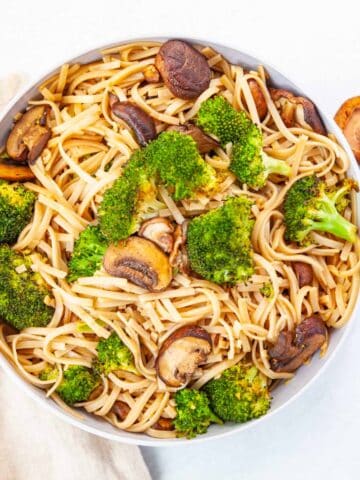
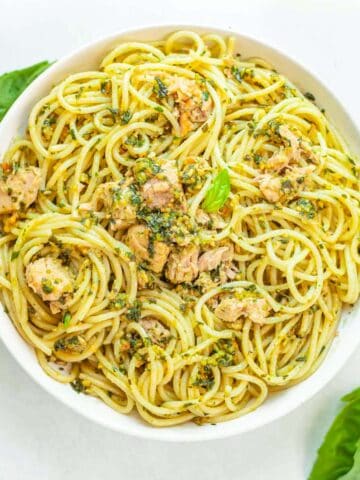
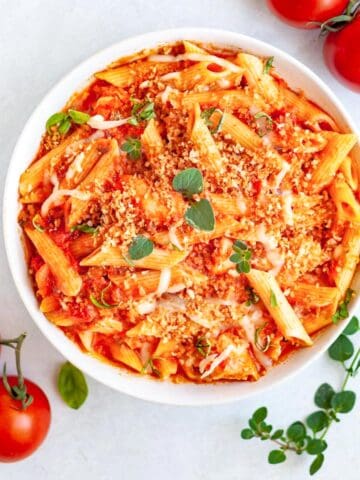
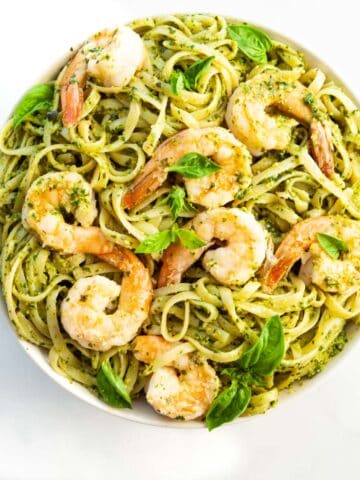
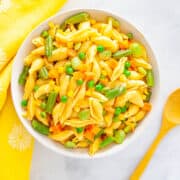
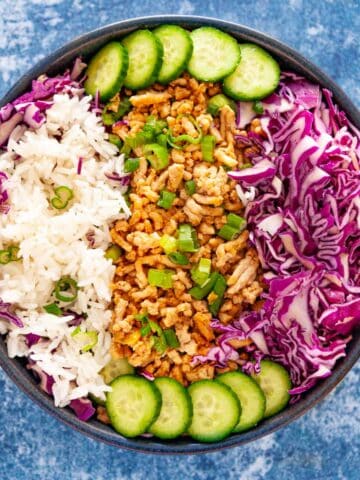
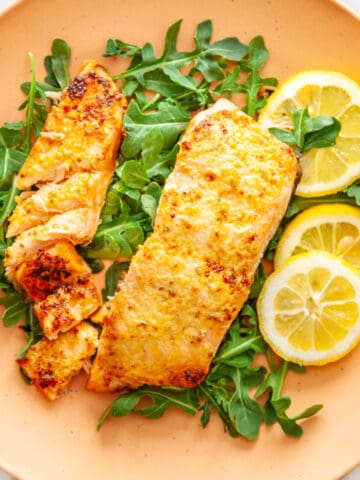
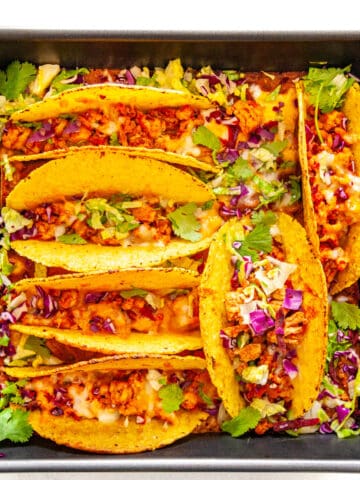
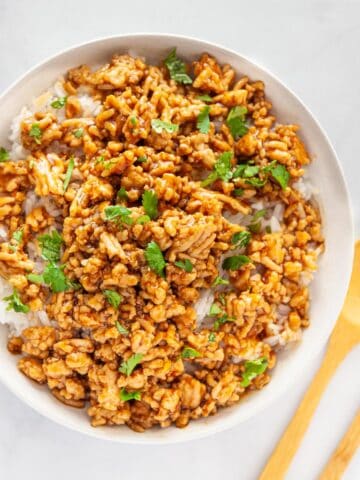
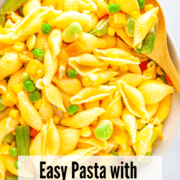
Marteny
Hi Jenny! Prepped this meal for hubby and it was a success! Thank you so much for sharing your recipe. I had some leftover rotisserie chicken, shredded it and added to your recipe, it was delicious also. ((I read through comments and one stood out more among the rest regarding "grammar police - Laura" kicking you down about your recipe grammatical errors? Hopefully "Laura" has a better day and turns her negativity into positivity. Wishing you and all of your readers a Happy, Healthy and Prosperous New Year in 2024!))
Jenny Meier
Thanks for the message, I'm happy to hear the recipe worked for you!
Laura
It's not "it's shape", it's "its shape". "It's" means "it is"; "its" means "belonging to it". For instance: yours, his, hers, ours, theirs - no apostrophe! Dang. Sick of it!
Jenny
Hi Laura, Thanks for your feedback. I also value good writing and proper punctuation and I will update the error. But just so you know, I understand grammar and how to write correctly. The writing error was not the result of ignorance. I cook, develop recipes, photograph all of the food and write the blog posts myself, often while my two kids are underfoot. So occasionally I make mistakes. A little patience and understanding is appreciated. Thanks!
David
Sometimes autocorrect (auto edit if your using a word processor) makes incorrect corrections you didn't see or want. Thank you for the wonderful quick and easy recipe, I enjoyed it immensely.
Syliva
Great recipe! Really appreciate the ratios to keep it a one pot dinner. Couldn't be easier on a busy weeknight.
Laura, I don't think you realize how aggressive your comment comes across. Grammatical mistakes are part of a diverse internet. You can get salty with a NYT recipe but honestly there's no proofreaders here and Jenny is making this available for free. I'm sick of unkind comments like YOU'RES*!
*Yep, did that just to tick you off 😛
Sara
So where's the garlic come in?
Jenny
Oops, thanks for the heads up! The garlic is added at the same time that you add the pasta to the broth. I've updated the recipe. Thanks!
Jen
This recipe makes a very simple dinner more flavorful. Perfect for busy nights when you don't know what to cook!
Catherine Willis
Delicious! I also love that this receipt is healthy, only requires one pot and uses frozen vegetables. Thanks for sharing!
Jenny Meier
Thanks for letting me know, glad you enjoyed it!